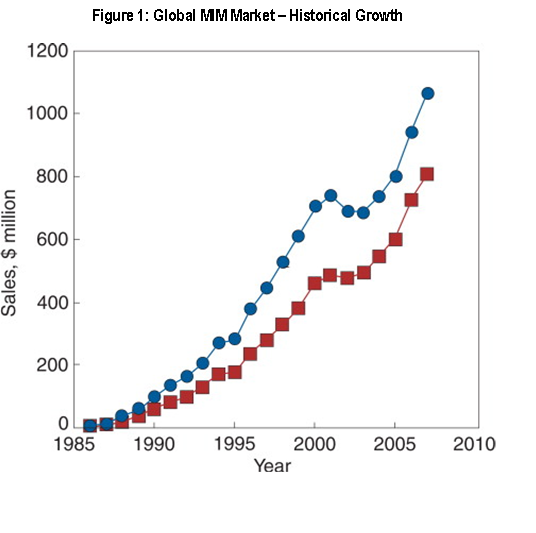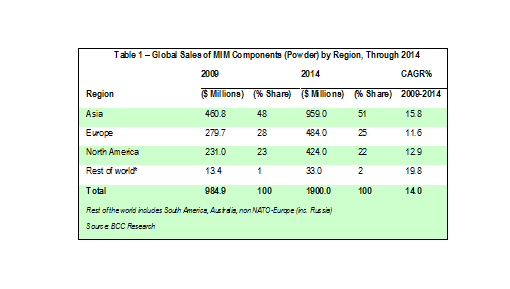Metal injection molding (MIM) is experiencing a worldwide boom, with an estimated market worldwide of more than $1bn per year, and compound annual growth rates estimated to be as high as 20%.
Material cost savings and reduced cycle times driving growth
MIM technology is used to form a near net-shape metal part by consolidating metal powder in a special sintering process. The lack of raw material waste, as well as reduced cycle times, can reduce costs by more than 50%. While the technology suffered from a shaky technology de-bugging period between its launch in 1970s and the new millennium, several players have now advanced MIM technology to the point that it is currently seen as a strong and reliable solution for overcoming several important economic challenges.
The explosive growth rates have been escalating as the technology receives increasing acceptance for high volume manufacturing of tightly-toleranced small metal components. The American MIM market is estimated at $250m, with 40 manufacturers in contract manufacturing and more than 10 original equipment manufacturers (OEMs) running captive operations. European demand is approximately $350 million, while the market in Asia, with China leading the growth, is approximately $550 million.
Firearms and medical segments see MIM as attractive option
Firearms and medical applications are the two main segments of MIM demand. Firearms OEMs made the transition to broad sourcing in MIM more than a decade ago, and continue to have growing interest in containing costs and expanding production. Despite (some say because of), the recent economic downturn, the US firearms industry has grown, and background checks for gun sales reached a record high in 2011. Domestic MIM players have a significant advantage over international players in firearms due to ITAR regulations, and those with an ability to respond to the recent ramp up in firearms demand have made significant strides in organic growth.
For example, Parmatech Corporation’s MIM capabilities give manufacturers the ability to make weapons from a range of materials using the same tooling, a feature not possible with casting or forging. Parmatech offers a MIM process that can use 4140 and MIM-4605 carbon steel, and 17-4 and 420 stainless steel, all with the same tooling.
By using this MIM process, firearms manufacturers can form several separate parts into one, consolidating a weapon’s mechanical components and reducing the component count. This significantly reduces development time and effort and improves supplier tracking. Producing multiple component parts that operate smoothly together is key to the modern firearms manufacturer. As modern weapon manufacturers design sophisticated firearms with numerous interlocking moving parts, they are turning to MIM to produce high volumes of components that can be assembled together without the need for costly machining and gunsmithing.
Medical MIM applications are also on the rise, primarily driven by a macroeconomic focus on dramatically reducing healthcare costs. While the European and US healthcare markets are somewhat mature, the global aging population creates opportunities for the medical industry. According to The Centers for Medicare and Medicaid Services, healthcare spending growth in the US will continue to grow more quickly than GDP for the foreseeable future, despite economic downturn periods.
For example, Parmatech Corporation is using MIM for parts used in manufacturing bariatric and laparoscopic instruments, including articulation gear for varying the direction of the working end of the device. The company is using MIM to produce complex, three dimensional shapes that are difficult or near impossible to manufacture using conventional fabrication technologies. MIM provides for complex shapes in a high volume manufacturing process, and supports the drive towards miniaturization of surgical devices and lowered costs for healthcare equipment. As a result of the trend towards miniaturization, most of the parts made with MIM technology weigh less than 50g, and can be additionally lightened by adding holes or pockets without sacrificing strength.
In addition, as US and European OEMs seek to penetrate emerging markets and the BRIC (Brazil, Russia, India and China) players, cost pressures become the primary success driver; thus, many medical OEMs are looking to cost-saving technologies like MIM with renewed interest.
Figure 1 illustrates the growth in MIM sales over the past 25 years. The upper curve traces global powder injection molding (PIM) annual sales versus calendar year and the lower curve shows the corresponding metal powder injection molding (MIM) contribution.
Macroeconomic drivers strongly support continued MIM growth. Table 1 illustrates the projected growth rates, with the global MIM market projected to grow from $985m in 2009 to $1.9bn in 2014, representing a 14.0% compound annual growth rate (CAGR). In North America, the market for MIM product is projected to grow from $23m in 2009 to $424m in 2014. In Europe, the market for MIM product is projected to grow from $280m in 2009 to $484m in 2014.
With such clear-cut macroeconomic and socioeconomic growth drivers, strong technical players in MIM can expect to bring more value to customers than any of us ever imagined.



